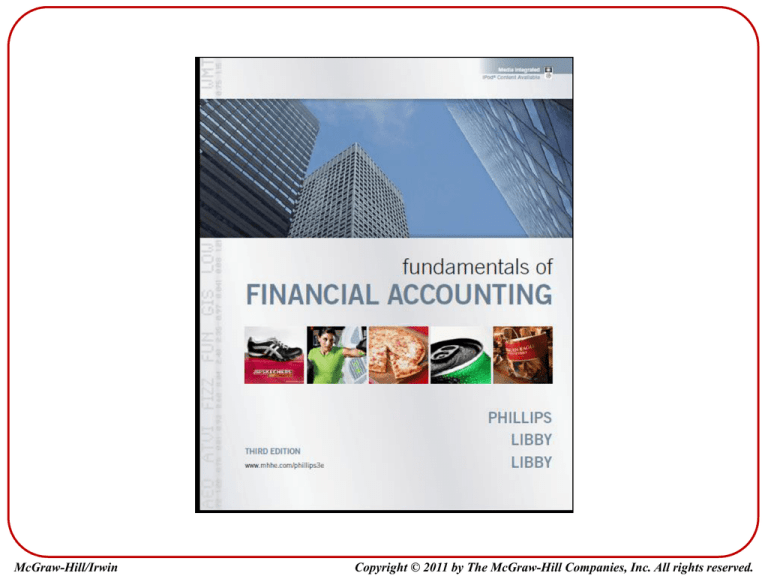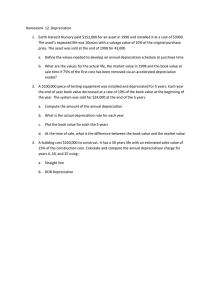
McGraw-Hill/Irwin
Copyright © 2011 by The McGraw-Hill Companies, Inc. All rights reserved.
Chapter 9
Reporting and Interpreting Long-Lived
Tangible and Intangible Assets
PowerPoint Authors:
Susan Coomer Galbreath, Ph.D., CPA
Charles W. Caldwell, D.B.A., CMA
Jon A. Booker, Ph.D., CPA, CIA
Fred Phillips, Ph.D., CA
Definition and Classification
Actively Used in Operations
9-3
Value represented by rights
that produce benefits.
Will not be
up within the next year
Intangibles
withused
a limited
life, such as patents and
copyrights, are subject to
Examples
amortization.
Land
Intangibles
Intangible
Tangiblewith an
Assets subject to depreciation
unlimited (or indefinite)
and
equipment
No
Physical
life,
such as goodwill and Buildings
Physical
trademarks,
FurnitureSubstance
and fixtures
Substanceare not
amortized.
Acquisition of Tangible Assets
Purchase cost
Legal fees
Surveying fees
Broker’s commissions
Purchase/construction cost
Legal fees
Appraisal fees
Architectural fees
Purchase/construction cost
Sales taxes
Transportation costs
Installation costs
Land
Buildings
Equipment
9-4
Maintenance Costs Incurred
during Use
Type of
Expenditure
9-5
Identifying Characteristics
Accounting
Treatment
Ordinary
1. Relatively small, recurring expenditures
repairs and
that maintain normal operating condition
maintenance 2. Do not increase productivity
3. Do not extend life beyond original
estimate
Expense
Extraordinary 1. Relatively large, infrequent expenditures
repairs,
such as major overhauls or replacements
replacements,
of major components
and additions 2. May extend useful life
3. May increase productivity or efficiency
Capitalize
Depreciation Expense
Depreciation is a cost allocation process that matches costs
of operational assets with periods benefited by their use.
Acquisition
Cost
Cost Allocaton
Balance Sheet
9-6
Expense
Income Statement
Depreciation
Expense
Depreciation for
the current year
Income
Statement
Accumulated
Depreciation
Total of depreciation
to date for an asset
Balance
Sheet
Depreciation Expense
2008 Depreciation
Includes $130 for 2008
Book value 2008
9-7
Summary of Depreciation Methods
9-8
Disposal of Tangible Assets
Update depreciation to date of disposal.
Record the disposal.
dr Cash (+A)
dr Accumulated Depreciation (-xA)
cr Equipment (-A)
cr Gain on Disposal (+R, +SE)
Gain if cash received is greater than asset’s book value
9-9
Book
value
Disposal of Tangible Assets
Update depreciation to date of disposal.
Record the disposal.
dr Cash (+A)
dr Loss on Disposal (+E, -SE)
dr Accumulated Depreciation (-xA)
cr Equipment (-A)
Loss if cash received is less than asset’s book value
9-10
Book
value
Intangible Assets
Often provide
exclusive rights
or privileges.
Noncurrent assets
without physical
substance.
Intangible
Assets
Useful life is
often difficult
to determine.
9-11
Usually acquired
for operational
use.
Intangible Assets
Record at current cash
equivalent cost, including
purchase price, legal fees,
and filing fees.
Amortize intangibles with
limited lives over the shorter
of their economic lives or
legal lives using the
straight-line method.
9-12
Trademarks and Copyrights
A trademark is a symbol, design,
or logo associated with a business.
Internally developed
trademarks have no
recorded asset cost.
Purchased trademarks
are recorded at cost.
A copyright is an exclusive right granted by the federal
government to protect artistic or intellectual properties.
Legal life is
life of creator
plus 70 years.
9-13
Amortize cost
over the period
benefited.
Patents and Licensing Rights
A patent is an exclusive right granted by the federal
government to sell or manufacture an invention.
Cost is purchase
price plus legal
cost to defend.
Amortize cost
over the shorter of
useful life or 20 years.
Licensing rights grant limited permission to use a product
or service according to specific terms and conditions.
You may be using computer
software that is made
available to you through a
campus licensing agreement.
9-14
Franchises
A franchise provides legally protected rights
to sell products or provide services purchased
by a franchisee from the franchisor.
9-15
Goodwill
Purchase Price > Fair Market Value of Net Assets Acquired
9-16
Occurs when one
company buys
another company.
Only purchased
goodwill is an
intangible asset.
Is not amortized.
Is impairment
tested and may be
written down.
Summary of Accounting Rules
for Long-Lived Assets
Stage
Subject
Acquisition Purchased Asset
Use
Tangible Assets
Capitalize all related costs
Intangible Assets
Capitalize all related costs
Expense related costs
Capitalize related costs
Not applicable
Not applicable
straight-line
units-of-production
declining-balance
Do not depreciate land
Typically use straight line only
Write-down if necessary
Write-down if necessary
Report gain or (loss) when . . . Receive more (less) on
disposal than book value
Receive more (less) on
disposal than book value
Repairs/maintenance
Ordinary
Extraordinary
Depreciation/ amortization
Limited life
Unlimited life
Impairment test
Disposal
9-17
Do not amortize
Impact of Depreciation
Differences
Accelerated depreciation, in the early years of an asset’s
useful life, results in higher depreciation expense, lower
net income, and lower book value than would result
using straight-line depreciation.
Selling an asset with a low book value, resulting from
accelerated depreciation, might result in a gain.
Selling the same asset with a higher book value,
resulting from straight-line depreciation, might result in
a loss.
9-18
Natural Resources
Depletion is the process of allocating a natural
resource’s cost over the period of its extraction.
Depletion is similar in concept to depreciation.
Depletion that is computed for a period is first added to
inventory and then expensed when the inventory is sold.
Total
depletion
cost
9-19
Cost of
goods sold
Inventory
for sale
Unsold
Inventory
Changes in Depreciation
Estimates
Predicted
residual value
Predicted
useful life
So depreciation
is an estimate.
Over the life of an asset, new information
may come to light that indicates the
original estimates need to be revised.
9-20
End of Chapter 9






